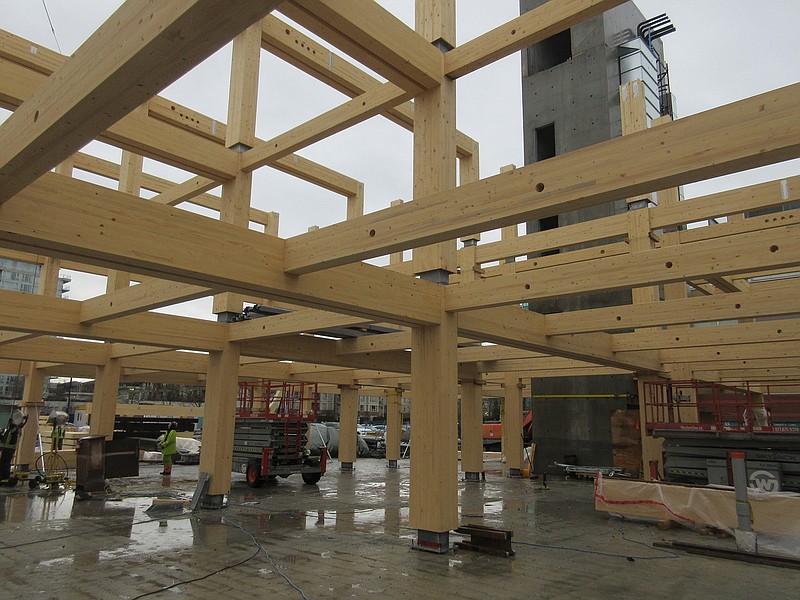SEATTLE - The loggers who Seattle a center of the national timber industry are long gone. And only a few wooden landmarks of the timber heyday, mostly churches, still exist on the low-slung skyline of Ballard, the neighborhood once known as Shingleton.
But as concerns over climate change give new life to wooden building design, that could change.
In the coming years, Ballard will be home to Seattle's first tall building built almost entirely from wood. Rising eight stories from the current Ballard Blossom florist on Market Street will be a hotel built principally from cross-laminated timber, or CLT - durable panels made from binding layers of wooden planks with adhesive.
The architects behind the hotel say its wooden structure "responds to the historical influence that timber has played" in Ballard.
More importantly, cross-laminated timber is touted as an environmentally sustainable alternative to concrete and steel, which generate large quantities of greenhouse gases in their production. Loggers and environmentalists alike say that building with cross-laminated timber needs to be one part of the response to climate change.
For those who remember the fiery 1990s protests over logging in the spotted owl's Olympic Peninsula habitat, building with wood seems counterintuitive.
Mark Wishnie, the director of global forestry at The Nature Conservancy, said he understands the whiplash that some feel about the environmental movement's about-face on timber. One of the biggest challenges to increasing demand for CLT construction, he said, is the "scars in people's memories" - the perception that logging equals deforestation.
For many, the old Shingletown symbolized just that kind of environmental catastrophe: mass deforestation, including the logging of old-growth forests.
That doesn't have to be the case, Wishnie said, if logging is managed well. But he emphasized that cross-laminated timber only makes sense if the wood comes from a forest that's managed responsibly.
Since an April code change made it easier for cross-laminated timber buildings to win city approval, developers have applied for permits for three such towers, including the Ballard hotel - and Seattle architects say plenty more are on their way.
The code change was "sort of like the dam breaking," said architect Jack Chaffin, who is designing one of the new cross-laminated timber buildings. He said he previously tried to build cross-laminated timber apartments, but always scrapped the designs because it would have added nearly a year to the permitting process.
Now, anticipating stepped-up demand from Seattle and elsewhere, two cross-laminated timber factories - Vaagen Timbers in Colville, Stevens County, and Katerra in Spokane - opened this summer, almost doubling the number of local cross-laminated timber producers.
Cross-laminated timber is a subset of mass timber - ultra-dense blocks of planks bound together with glue or nails. Mass timber is far from new: In 1982, the Tacoma Dome was framed with thousands of glue-laminated beams, a form of mass timber.
But until recently, architects weren't able to envision building hundred-foot-plus towers entirely of wood, because fire codes in cities such as Seattle wouldn't allow it.
Enter cross-laminated timber: Fire-resistant wood panels capable of replacing concrete in floors, walls and ceilings. It's produced in 12-foot by 60-foot panels and cut by computer into prefabricated patterns, ensuring a minimum of construction waste.
As the Seattle area continues to grow - by close to 600,000 people in the next 20 years, the state estimates - the city will need to balance the need to build new housing stock with the need to eliminate waste and carbon emissions from construction, environmentalists say.
The huge environmental benefits of cross-laminated timber are its biggest draw: Construction on a cross-laminated timber high-rise emits roughly 25% less carbon dioxide than if the high-rise were concrete, according to a University of Washington study.
Timber buildings also store atmospheric carbon locked in the trees used to build them. And greenhouse gases are sequestered even further as forestry land is replaced and new trees absorb carbon dioxide.
"When we take the wood out of the forest, we are planting new forest and sequestering new carbon," said Indroneil Ganguly, associate professor at the UW's School of Environmental and Forest Sciences and one of the authors of the study. Building with timber, he said, is "almost like multiplying the acres of forest."
But Seattle is months or even years behind other Pacific Northwest cities in adopting large-scale cross-laminated timber construction.
As of now, the city has one house and one classroom made of the material. Contrast that with Tacoma, where the six-story Brewery Blocks apartments will open this fall and a 127-room hotel is under construction at Joint Base Lewis-McChord; or Spokane, where the 150,000-square-foot Catalyst office building will open next year. Portland's Carbon 12 condominium opened in 2017, and the University of British Columbia has been using the material for years.
In Seattle, the Ballard hotel will be joined by two cross-laminated timber apartment buildings on Capitol Hill - an eight-story project at 621 Ninth Ave. and a 12-story project at 1422 Seneca St. - assuming plans don't change as the permitting process progresses.
All three are concrete-CLT hybrids, and it's unlikely an entirely wood tower will come to Seattle anytime soon. That's because codes encourage that some of the building's earthquake-proofing elements be made from concrete - even though in theory, cross-laminated timber should perform well in an earthquake, so long as the rigid panels are joined together to form a flexible wall system, said Erica Spiritos, preconstruction manager for Swinerton Mass Timber in Portland.
While Seattle technically allows 18-story cross-laminated timber towers, most projects will likely remain in a six- to 12-story "sweet spot" - too high to use traditional lumber because of fire safety, but too short to make the extra expense of reinforced concrete pencil out, architects say.
Advertising
At the Seneca Street development, cross-laminated timber was chosen because the site is under 7,000 square feet, making it hard to fit the machinery needed for a concrete tower, said architect Lauren Garkel. (She designed both the Seneca Street project and the Ballard hotel.)
The cross-laminated timber panels will be prefabricated off-site, then lifted into place by a single crane in a matter of weeks, "like an Erector Set," Garkel said. "The construction team is a handful of people with a drill."
Cross-laminated timber buildings go up quickly. The developer behind the Joint Base Lewis-McChord hotel - Australian firm LendLease, an early cross-laminated timber adopter - estimates it employs half the number of people on CLT projects as on traditional projects, and for only two-thirds of the time.
It can be hard to get used to the sight of a skeleton crew assembling a 100-foot tower out of screws and bolts, said Chaffin, who is designing the Ninth Avenue development. "It's sometimes eerily quiet."
There can be a similar sense of quietude inside the building, where inhabitants are cocooned by wood that's often left exposed and natural. Proponents of cross-laminated timber often make the point that buildings with natural design elements lower stress and improve mood, what's called the "theory of biophilia." Scientific evidence supporting the theory is limited - but it feels intuitive.
Living in a cross-laminated timber building is like being "inside a spa," said architect Susan Jones, who designed Seattle's first cross-laminated timber house for her family.
When she started designing the home, part of cross-laminated timber's draw was its sheer beauty. In her Madison Park house, as in many cross-laminated timber buildings, the exposed wood - in a myriad of colors and textures - sings out from walls, floors and ceilings.
Jones moved into her new house in 2015. By that point, she'd turned into a CLT evangelist, helping to draft national and state building-code changes that she hoped would pave the way for more and bigger wooden buildings. Now, her firm, atelierjones, is designing two CLT towers for Seattle clients.
"It's amazing to think that all this journey started with the desire to build a family house in Seattle," she said. "And out of that, we have 12-story buildings being designed."
At least some of the excitement about cross-laminated timber, though, is overblown. As if it weren't enough that cross-laminated timber is beautiful, quick to build and sustainable, some proponents also predict it will jump-start local demand for Washington lumber.
A study from the University of Washington and conservation group Forterra punctured that balloon. It estimated that by 2040, local demand for cross-laminated timber would account for less than 1% of the annual Pacific Northwest timber harvest - so a CLT boom isn't likely to create a huge number of new forestry jobs.
And some environmental concerns around logging remain. Even if demand for timber does increase, that could complicate rather than alleviate environmental problems unless foresters manage their land sustainably - meaning forest thinning, not clear-cutting; plenty of clearance around streams; and a longer growth cycle.
"The market around forest products is optimized to get the most product to customers at the lowest dollar," said Brad Kahn, a spokesperson for the Forest Stewardship Council, which certifies sustainable logging practices. "It's not optimized for stream protection."
Meanwhile, environmentalists say no city is currently building cross-laminated timber structures fast enough to stave off the most devastating effects of climate change.
"If cross-laminated timber is going to make a difference for climate, we're going to need to rapidly scale it up," The Nature Conservancy's Wishnie said. "A single building is great. But to really make a difference for climate, we need to rapidly increase the pace."


